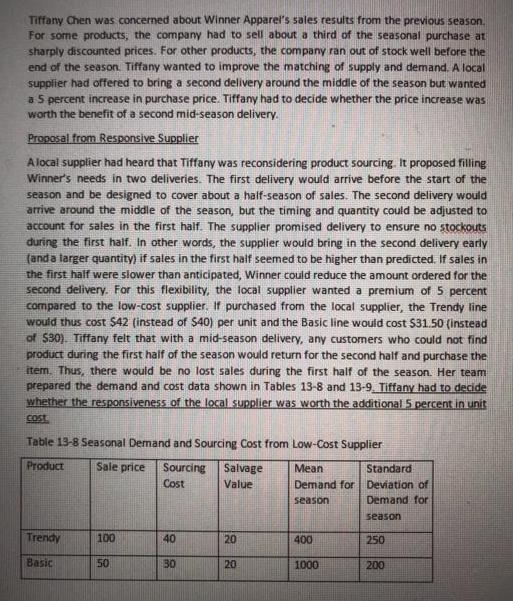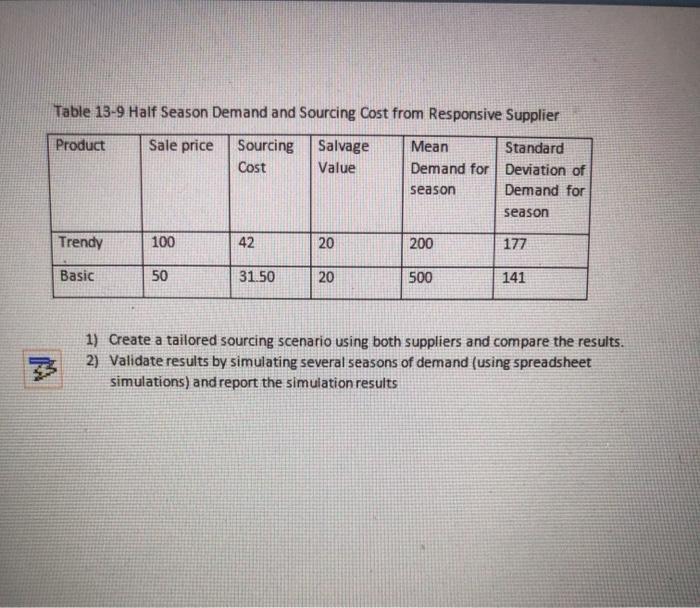Answered step by step
Verified Expert Solution
Question
1 Approved Answer
Tiffany Chen was concerned about Winner Apparel's sales results from the previous season. For some products, the company had to sell about a third


Tiffany Chen was concerned about Winner Apparel's sales results from the previous season. For some products, the company had to sell about a third of the seasonal purchase at sharply discounted prices. For other products, the company ran out of stock well before the end of the season. Tiffany wanted to improve the matching of supply and demand. A local supplier had offered to bring a second delivery around the middle of the season but wanted a 5 percent increase in purchase price. Tiffany had to decide whether the price increase was worth the benefit of a second mid-season delivery. Proposal from Responsive Supplier A local supplier had heard that Tiffany was reconsidering product sourcing. It proposed filling Winner's needs in two deliveries. The first delivery would arrive before the start of the season and be designed to cover about a half-season of sales. The second delivery would arrive around the middle of the season, but the timing and quantity could be adjusted to account for sales in the first half. The supplier promised delivery to ensure no stockouts during the first half. In other words, the supplier would bring in the second delivery early (and a larger quantity) if sales in the first half seemed to be higher than predicted. If sales in the first half were slower than anticipated, Winner could reduce the amount ordered for the second delivery. For this flexibility, the local supplier wanted a premium of 5 percent compared to the low-cost supplier. If purchased from the local supplier, the Trendy line would thus cost $42 (instead of $40) per unit and the Basic line would cost $31.50 (instead of $30). Tiffany felt that with a mid-season delivery, any customers who could not find product during the first half of the season would return for the second half and purchase the item. Thus, there would be no lost sales during the first half of the season. Her team prepared the demand and cost data shown in Tables 13-8 and 13-9. Tiffany had to decide whether the responsiveness of the local supplier was worth the additional 5 percent in unit cost Table 13-8 Seasonal Demand and Sourcing Cost from Low-Cost Supplier Product Sale price Sourcing Salvage Cost Value Trendy Basic 100 50 40 30 20 20 Mean Standard Demand for Deviation of season Demand for season 400 1000 250 200 Table 13-9 Half Season Demand and Sourcing Cost from Responsive Supplier Product Mean Standard Demand for Deviation of season Demand for season Trendy Basic Sale price Sourcing Salvage Cost Value 100 50 42 31.50 20 20 200 500 177 141 1) Create a tailored sourcing scenario using both suppliers and compare the results. 2) Validate results by simulating several seasons of demand (using spreadsheet simulations) and report the simulation results
Step by Step Solution
★★★★★
3.48 Rating (151 Votes )
There are 3 Steps involved in it
Step: 1
step 1 Company WA was experiencing overstocking and understocking problems due to improper demand forecast techniques Currently the company is using a low cost strategy A supplier offered to deliver p...
Get Instant Access to Expert-Tailored Solutions
See step-by-step solutions with expert insights and AI powered tools for academic success
Step: 2

Step: 3

Ace Your Homework with AI
Get the answers you need in no time with our AI-driven, step-by-step assistance
Get Started


